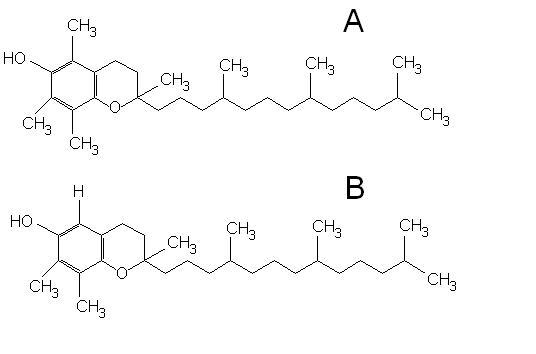Cigarette smoke is known to drastically increase the oxidative and nitrosative stress placed on the human body through generation of reactive oxygen (ROS) and nitrogen species (RNS). This oxidative stress results from free radicals present in the cigarette smoke in both the tar and gas phases, in addition to the free radicals generated as a result of inflammation caused by smoking. In particular cigarette smoke is thought to stimulate inflammation involving neutrophils and macrophages. In addition, cigarette smoke contains nitric oxide which can be oxidised to nitrogen dioxide or can react with the superoxide radical to form peroxynitrite. The high burden of oxidative stress caused by cigarette smoke depletes the body of antioxidants, which can eventually lead to disease. Bruno and Traber (2005)1 have reviewed the requirements of vitamin E on humans and in their paper suggest that individuals who regularly smoke cigarettes are depleted in vitamin E.
Vitamin E is a group of isomers that share the biological activity of α-tocopherol. The two most biologically important isomers are α-tocopherol and γ-tocopherol. Structurally α-tocopherol has a fully methylated chromanol head, but γ-tocopherol has an unsubstituted group in the 5-position (figure 1). This structural nuance allows γ-tocopherol to undergo peroxynitrite-mediated nitration leading to the formation of 5-nitro-γ-tocopherol (NGT). Plasma γ-tocopherols is particularly susceptible to peroxynitrite from cigarette smoke because peroxynitrite is prone to target lipophilic compounds such as tocopherols. Exposure of humans to cigarettes in known to increase plasma level of NGT from 3 to 134 nmol/L and decrease plasma levels of γ-tocopherol by up to 60%. Smoking also depletes the body of α-tocopherol via oxidation and subsequent metabolism to α-carboxy-ethyl-hydroxy-chroman via the cytochrome P450 pathway. Smokers with depleted levels of α-tocopherol also have low levels of ascorbic acid, supporting the theory that α-tocopherol is depleted via oxidation.
Smokers may therefore require additional vitamin E and vitamin C in order to maintain optimal antioxidant function. Vitamin C is known to regenerate tocopherol from the tocopherol radical, so it is possible that as ascorbic acid levels drop due to increased systemic oxidative stress through smoking, α-tocopherol disappearance rates from plasma increase. This in turn increases the excretion of α-carboxy-ethyl-hydroxy-chroman which may therefore be a good urinary marker of tocopherol status in smokers. Obviously it would improve health more to stop smoking rather than rely on increased intakes of vitamin C and vitamin E. However, epidemiological evidence does suggest that diets rich in antioxidant nutrients are protective of the diseases associated with smoking. Antioxidant interactions are complex, as illustrated by the increased risk of lung cancer in smokers who consume supplemental β-carotene. Care should therefore be exercise when supplementing with single nutrients in isolation.
Figure 1. α-tocopherol (A) and γ-tocopherol (B) structure.
RdB

